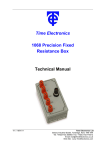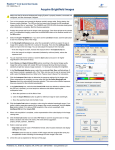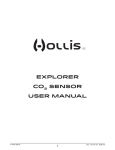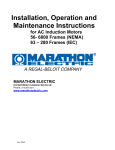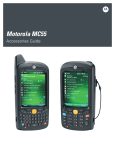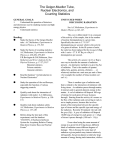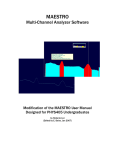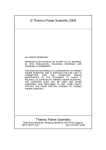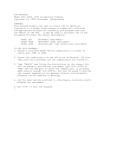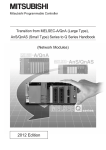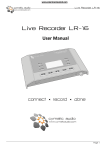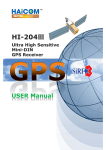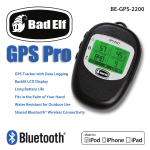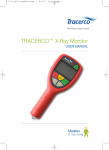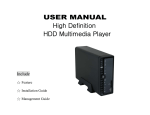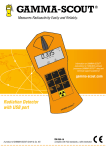Download The NukAlert-ER Detailed Manual
Transcript
The NukAlert-ER Detailed Manual The NukAlert-ER is a unique radiation detection and measurement instrument. It is a Geiger Counter in the truest sense, but it is able to measure radiation levels far higher than traditional Geiger based devices. Traditional Geiger counters sized for sensitivity adequate to measure background radiation levels are inherently incapable of measuring the life threatening levels possible from a power plant catastrophe or nuclear attack. Unlike the NukAlert-ER, the "dead time" of traditional Geiger counter circuits causes a sensitive counter to become inoperative above about 100mR/hr (a level which may be a long term health risk, but is far below immediately life threatening). The NukAlert-ER uses sophisticated high-voltage control circuitry and statistical analysis of the pulses from the Geiger tube to enable radiation measurement over an intensity range from 1 uR/hr to 600R/hr. This technique is referred to as "Time to First Count" in radiation detection textbooks. The NukAlert-ER is the first inexpensive portable instrument to employ the TTFC method. The result is a single device that can be used as a sensitive Geiger counter, survey meter and dosimeter. Its wide dynamic range facilitates the location of shelter, aids decontamination of people, allows preliminary evaluation of food, and measures wind blown fallout from distant sources. When the unit is on the yellow light blinks and corresponding clicks are produced at least a few times per minute, indicating proper operation and normal harmless background radiation. Up to a few clicks per second can be expected from normal background radiation. Some high background locations or flying in an airliner at cruising altitude can cause as many as 10 clicks per second without being a cause for alarm. The NukAlert-ER may be used as a stand alone instrument, or it may be connected through its USB port to a computer or companion device allowing its data to be collected, displayed on large screens and/or sent over the internet. The NukAlert-ER Gateway communication device is available from www.nukalert.com/ In a radiation emergency the instrument should be used sealed in a ziplock plastic bag to avoid getting contamination on or in the unit. Because the NukAlert-ER covers an enormous range of radiation intensity (the billion fold range between harmless and deadly), it is imperative to understand the measurement units described in the Dose Rate section of this manual. The On/Sleep button: The NukAlert-ER may be powered by two "AA" batteries (alkaline or NiMH) and/or a USB power source (computer or universal cell phone charger). The instrument is turned on by pressing and holding the On/Sleep button for 5 seconds. The back-light will blink, then come on, followed by ramping of the high voltage and entry of the main menu at the Dose Rate display screen. While On (Awake), the unit may be returned to the sleep mode by momentarily pressing the On/Sleep button followed by pressing the "OK" button. The instrument will come on automatically when it first receives a source of power (default setting). This setting is necessary to enable power outage recovery during automatic reporting) The Mute button: The Mute button toggles the Geiger clicking sound on or off. It will not mute any other sounds. The "OK" button: The "OK" button is used to accept menu options or to temporarily silence (snooze) alarms that are sounding. When The Dose Rate is being displayed, pressing the "OK" button causes an asterisk "*" to appear beside the reading and remain for the duration of the selected averaging period as a guide to determine when the indication has fully stabilized. While in the settings menu, parameters that are shown in parenthesis may be adjusted by pressing "OK" and then using the arrow keys. When the desired value is shown press "OK" again to accept the adjustment, or "ESC" to restore the original value. The "ESC" button: The "ESC" button is used to back out (escape) from a menu or sub-menu selection. Repeated pressing of the "ESC" button always pages back to Dose Rate screen. The "Left" & "Right" arrow buttons: The arrow buttons are used to page through the menu and sub-menu selections and to adjust settings. The NukAlert-ER presents the user with 8 main menu screens that are chosen with the "Left" or "Right" arrow buttons. The main menu selections are: Dose Rate Accumulated Dose Time Remaining to Preset Dose Count Rate Raw Counts History Battery State Periodic Wake Settings Dose Rate: This main menu selection displays the rate of radiation dose accumulation. The quantity of radiation a person absorbs is called a dose. Radiation dose is expressed on the NukAlert-ER display in units of either "R" (Roentgens), or "Sv" (Sieverts). [1 Sievert = 100 Roentgens]. The default unit is Roentgens. Units may also be shown on the NukAlert-ER display with a "n" (nano) prefix for billionths, a "u" (micro) prefix for millionths, a "m" (milli) prefix for thousandths, and a "K" (Kilo) prefix for thousands. The "Dose Rate" is a measure of how rapidly a dose is being absorbed. For example, a dose rate of 2R/hr (2 Roentgens per hour) will result in a dose of 6R being absorbed in three hours. At 2mR/hr (2 milli Roentgens per hour) it would take over 4 months to receive the same 6R dose. A typical normal background rate is between 10uR/hr and 100uR/hr. In an airliner at cruising altitude one would typically see 400uR/hr. due to cosmic rays from outer space. Airline crews work in such radiation fields for hundreds of hours per year without panic. Our bodies continuously repair most radiation damage. This process takes place over a period of weeks or months. At high radiation dose rates the healing process is overwhelmed by the accumulation of radiation damage to cells. A dose of more than 100R absorbed over a short time period (days) is likely to cause a person to develop symptoms of acute radiation sickness, while lower doses rarely cause acute illness. The average American has a 24% chance of lifetime fatal cancer. A 100R dose increases that cancer risk to about 32%, while a 10R dose increases lifetime fatal cancer risk less than 1%. Accumulated Dose: This main menu selection displays the total dose of radiation accumulated since the the accumulator was reset and the amount of time that has elapsed. If the instrument is put in the "Sleep" mode, or power is removed, the last reading will be stored in nonvolatile memory and it will be used as the starting point for accumulation when operation is restored. Radiation encountered while the unit is unpowered or in sleep will not be recorded, thus the "Accumulated Dose" may be in error. The dose reading can be reset to zero in the "Settings" menu. The choice of display units in either Sieverts or Roentgens is made in the "Settings" menu. Time Remaining to Preset Dose: This main menu selection displays the time remaining at the currently measured average dose rate until a preset total dose will have been accumulated. If the Dose Alarm is enabled, the alarm will sound when the preset dose has been accumulated. This function will not appear in the main display screens unless it has been initialized in the "Settings" menu. If the instrument is put in the "Sleep" mode, or power is removed, the last reading will be stored in nonvolatile memory and it will be used as the starting point for accumulation when operation is restored. Radiation encountered while the unit is unpowered or in sleep will not be recorded, thus the "Accumulated Dose" may be in error. The preset dose is chosen in the "Settings" menu. This reading may be cleared to zero in the "Settings" menu with the "Reset Dose" function. Count Rate: This main menu selection displays the average number of Geiger pulses observed in a given time (either one second or one minute, depending on the radiation intensity). The averaging time period is adjustable in the "Settings" menu. Raw Counts: This main menu selection displays the total number of Geiger pulses observed in an elapsed period of time. Pressing the "Left" key followed by "OK" will reset the count and time. pressing the "Right" key shows the total number of pulses received in the last full hour. This function is useful for making high resolution background measurements. History: This main menu selection enters a sub-menu that allows the user to review or clear the history memory. The results of the last 500 averaging periods of radiation measurements are kept in the unit's memory with the most recent measurements overwriting the oldest. The History may also be read through USB by a PC App. Browse History: The time stamped log entries are displayed on the LCD display. The logging interval (time between log entries) is equal to the averaging time selected in the settings menu - for example, if the averaging time is set for 120 seconds, the log entries will be two minutes apart, and the entire log will contain the most recent 16 hours of readings. Pressing the "Left" key moves backward in time through the log, while pressing the "Right" key moves forward in time. Pressing the "Esc" key returns to the main menu. Clear History: Press "OK" to erase all previous history entries. Battery State: The present battery voltage is displayed along with an estimated percentage of battery capacity remaining. The percentage is based on NiMH rechargeable batteries. If alkaline batteries are used, a percentage above 100% will be seen with fresh batteries. If a USB connection is delivering power, a (USB pwr) message will be displayed beside the measured battery voltage, and the batteries will not be drained. Periodic Wake: This main menu function is enabled by selecting the desired wake interval with the arrow keys. When enabled, the sleep state will be interrupted by a periodic wake-up, a measurement period, and return to sleep at the selected time interval. The awake time will be the duration of the averaging window selected in the Settings Menu, "Set Avg window". During the awake time, the unit will measure the ambient radiation level and store the result in the history memory. While the unit is asleep with this function enabled, the LED will blink at a regular 1 second rate. The unit may be awakened manually at any time and will remain awake until the ON/Sleep button is pressed again. When the unit awakens autonomously, it will remain awake indefinitely if any key is pressed and may be returned to the sleep mode manually. The Periodic Wake mode can be used to greatly extend battery life – for example a Wake Period setting of 30 minutes coupled with an Avg Window of 30 sec will extend the battery life 60 fold for over 5 months of periodic monitoring. If an invalid combination is selected (Avg Window greater than Wake Period) the unit will refuse to sleep. Settings: This main menu selection enters the following sub-menu when the "OK" button is pressed. The"Left" or "Right" arrow buttons are then used to select the desired function which is entered by again pressing the "OK" button. Pressing the "ESC" button returns to the main menu. The present setting is shown in parenthesis. Press the OK button to allow adjustment of the parameter with the "Left" or "Right" arrow buttons. Then press the OK button to accept the new setting, or the ESC button to leave the setting unchanged. The Settings menu selections: Set Units Set Avg Window Set Backlight Set Dose Alarm Set Dose Limit Set Rate Alarm Set Rate Limit Reset Dose Set Time/Date Pwr restore wake Restore Defaults Software Version # System Test Set Units: This settings menu selection toggles between Sievert and Roentgen units of measure with the "Left" or "Right" arrow buttons. Set Avg Window: This settings menu selection adjusts the dose rate averaging window. A short time setting will allow rapid indication of radiation intensity changes, but the displayed indication will appear less stable. A longer time will allow more precise measurement at low intensities. This selection also controls the interval between log entries. Set Back-light: This settings menu selection adjusts the duration of back-lighting of the display while using batteries. The back-light is on continuously when the instrument is powered from a USB source. Set Dose Alarm: This settings menu selection toggles between enabled and disabled Dose alarm function with the "Left" or "Right" arrow buttons. When enabled, the alarm will sound when the accumulated dose exceeds the "Dose Limit" selected in the "Settings" menu. Set Dose Limit: This settings menu selection adjusts the Dose Limit amount. This setting is used by the "Dose Alarm" and the "Time Remaining to Preset Dose" functions. If the Dose Alarm is on, the Time Remaining to Preset Dose will be available in the main menu. Set Rate Alarm: This settings menu selection toggles between enabled and disabled Dose Rate alarm function with the "Left" or "Right" arrow buttons. Set Rate Limit: This settings menu selection adjusts the Dose Rate Limit amount. This setting is used by the "Rate Alarm" function. Reset Dose: This settings menu selection resets the dose accumulator used by the "Dose Alarm" and the "Time Remaining to Preset Dose" functions. Pressing the "OK" button clears the accumulator and returns to the "settings menu". Set Time/Date: This settings menu selection is used to adjust the internal clock for the History time stamp. The setting may be maintained while changing batteries by first entering sleep mode or plugging into a USB power source. The Time & Date may also be synchronized with a PC clock using the PC App and a USB connection. Pwr restore wake: This settings menu selection toggles the power up behavior of the instrument between automatic turn on (default), and manual turn on required. Restore Defaults: This settings menu selection restores the factory default settings if OK is pressed. Software Version # This settings menu selection displays the version number of the installed software (firmware) and the check-sum for verifying the software integrity. Self Test: This settings menu selection enters a sub-menu for testing various functions of the instrument. Tube Threshold: This System Test menu selection measures the threshold voltage of the Geiger tube. A check source of radiation that delivers more than 100 counts per minute is required for accurate results. Background radiation may be used for the test, but the result may be variable and as much as 30V high. Significant increase of the threshold over time (more than 50V) may indicate a defective Geiger tube. USB Connection and PC Apps: The main functions of the NukAlert-ER and much more may be accessed through the USB connection to a computer or the Companion Docking Station. An App must first be loaded on the host device (PC). A link to download a free open source PC App for USB communication with the instrument may be found on the NukAlert web page www.nukalert.com/ This App has a wide variety of capabilities that are documented in the App user's manual on the site. When the NukAlert-ER is connected to a computer by the USB cable, it receives all of its needed power from the computer and the batteries are not depleted. If batteries are in place during USB operation, the unit will continue operation during USB power interruptions. In order to safely accommodate many battery types, no battery charging is done by the NukAlert-ER itself. However, rechargeable batteries may be used and charged externally. In a radiation emergency: If the Dose Rate shows any amount of uR/hr (micro R per hour) you are not in life threatening radiation. Remain calm, download the resources listed at the end of this document if possible. If the Dose Rate shows less than 10 mR/hr (milli R per hour) you are not in the Hot Zone. Unless the radiation level increases, you may spend days in that radiation level without harm. In a radiation emergency the instrument should be used sealed in a ziplock plastic bag to avoid getting contamination on or in the unit. In the event of a terrorist nuclear attack: The following from the NCR Planning Factors for Nuclear Terrorism may be useful: http://www.fas.org/irp/agency/dhs/fema/ncr.pdf Immediately find the nearest and strongest building and go inside to avoid radioactive dust outside. - Go deep inside. If better shelter, such as a multi-story building or basement can be reached within a few minutes, go there immediately. If you are in a car, find a building for shelter immediately. Cars do not provide adequate protection from radioactive material. Go to the basement or the center of the middle floor of a multi-story building (for example the center floors (e.g., 3 – 8) of a 10-story building). Resist your natural instinct to evacuate from a dangerous area as you are likely to be much safer sheltering in place while the radiation outside weakens. Put building walls, brick, concrete or soil between you and the radioactive material outside, and increase the distance between you and the exterior walls, roofs, and ground, where radioactive material is settling. Stay inside. Do not come out until you are instructed to do so by authorities Air does not become radioactive, only the dust emits radiation. Avoid breathing dust by breathing through a cloth. If visible dust is not in the air, this is unnecessary. Use the NukAlert-ER to find the lowest Dose Rate location in your shelter. Radiation levels can vary enormously over short distances and may increase or decrease with time as the dust settles. Keep evaluating your shelter and probing for better locations. Specifications: Size & Weight: 135mm x 70mm x 25mm, 165g Power source: 2ea AA alkaline or NiMH cells, or USB Battery Life (2600mAhr Alkaline): Up to 65hr at background count rate ~32hrs between 1mR/hr and 10mR/hr ~24hrs Geiger above 100mR/hr Up to 1 year in periodic monitor mode Up to 3 years sleep mode Data access by: Display, USB, or optional Blue tooth Display: 2 line x 16 character back-lit LCD, Operating environment: -15°C to +65°C, Altitude to 5Km 0 to 95% humidity (non condensing) Geiger system: Active electronic quenching High rate measurement method: Time To First Count Tube Voltage: Adjustable by software up to 1000V Geiger tube: Supplied with KR-121 Geiger tube Other tubes available as options Compensation: Optional Sn/Cu Gamma Sensitivity: 18 counts/sec @ 1mR/hr (10μSv/hr) Accuracy (Cs137): ± 20% background through 600R/hr Saturation: No saturation below 1000R/hr Background: <10 counts/minute (Shielded) Beta sensitivity: Through front window above 200KeV Useful Resources: "What To Do If A Nuclear Disaster Is Imminent!": www.ki4u.com/guide.htm Civil Defense resources: www.ki4u.com/goodnews.htm Radiation Dose Chart: http://xkcd.com/radiation/ Physicians for Civil Defense: www.physiciansforcivildefense.org/ NCR Planning for Nuclear Terrorism: www.fas.org/irp/agency/dhs/fema/ncr.pdf NOTES:





